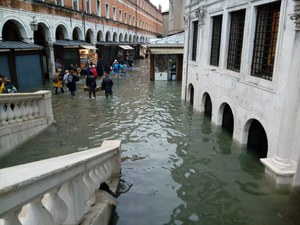Venice, 2019: the ”Acqua Alta” year. A focus on November events.
The year 2019 will be remembered for the extraordinary frequency of floodings and the extremely hight sea level recorded in the city of Venice. What happened? The exceptional event of November 12, 2019 was due to the combined effect of many meteorological components: the high astronomical syzygy tide, the unusual high mean sea level of the Mediterranean Sea in November, reflecting an anomalous general atmospheric depression over the basin, a deep small-scale atmospheric pressure minimum developed over the Adriatic, moving rapidly northward and passing over the Venice lagoon and causing local winds of about 100 m/s
On November 12, 2019 the sea level reached 189 cm, and this event represents the second higher storm surge, following the widespread flood event of 1966 (194 cm), but it was just the first of many subsequent flooding events: during just one week, Venice has been exposed to 4 storm surges exceeding the threshold of 140 cm and lasting about 50 hours.
In order to promptly face these floodings events and to manage their occurrence, the Tidal Forecast and Information Center - Municipality of Venice (CPSM), the Italian National Institute for Environmental Protection and Research (ISPRA) and the National Research Council - Institute of Marine Sciences (CNR-ISMAR) are strongly and efficiently collaborating in sea level monitoring and forecasting activities. Moreover they collaborated for a deep technical-scientific analysis of these events that was possible thanks to the continuous and extensive monitoring of meteo-marine parameters in the North Adriatic sea, through the 42 measurement stations managed by ISPRA and CPSM.
This is an important example of close and fruitful collaboration among Public Institutions serving the citizien and the society.

